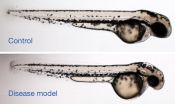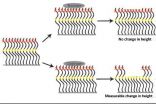(Press-News.org) LA JOLLA, CA—October 13, 2014—A new study by scientists from The Scripps Research Institute (TSRI), Lawrence Berkeley National Laboratory (Berkeley Lab) and other institutions suggests a cause of amyotrophic lateral sclerosis (ALS), also known as Lou Gehrig's disease.
"Our work supports a common theme whereby loss of protein stability leads to disease," said John A. Tainer, professor of structural biology at TSRI and senior scientist at Berkeley Lab, who shared senior authorship of the new research with TSRI Professor Elizabeth Getzoff.
Getzoff, Tainer and their colleagues, who focused on the effects of mutations to a gene coding for a protein called superoxide dismutase (SOD), report their findings this week in the online Early Edition of the Proceedings of the National Academy of Sciences. The study provides evidence that those proteins linked to more severe forms of the disease are less stable structurally and more prone to form clusters or aggregates.
"The suggestion here is that strategies for stabilizing SOD proteins could be useful in treating or preventing SOD-linked ALS," said Getzoff.
Striking in the Prime of Life
ALS is notorious for its ability to strike down people in the prime of life. It first leapt into public consciousness when it afflicted baseball star Lou Gehrig, who succumbed to the disease in 1941 at the age of only 38. Recently, the ALS Association's Ice Bucket Challenge has enhanced public awareness of the disease.
ALS kills by destroying muscle-controlling neurons, ultimately including those that control breathing. At any one time, about 10,000 Americans are living with the disease, according to new data from the Centers for Disease Control and Prevention, but it is almost always lethal within several years of the onset of symptoms.
SOD1 mutations, the most studied factors in ALS, are found in about a quarter of hereditary ALS cases and seven percent of ordinary "sporadic" ALS cases. SOD-linked ALS has nearly 200 variants, each associated with a distinct SOD1 mutation. Scientists still don't agree, though, on just how the dozens of different SOD1 mutations all lead to the same disease.
One feature that SOD1-linked forms of ALS do have in common is the appearance of SOD clusters or aggregates in affected motor neurons and their support cells. Aggregates of SOD with other proteins are also found in affected cells, even in ALS cases that are not linked to SOD1 mutations.
In 2003, based on their and others' studies of mutant SOD proteins, Tainer, Getzoff and their colleagues proposed the "framework destabilization" hypothesis. In this view, ALS-linked mutant SOD1 genes all code for structurally unstable forms of the SOD protein. Inevitably some of these unstable SOD proteins lose their normal folding enough to expose sticky elements that are normally kept hidden, and they begin to aggregate with one another, faster than neuronal cleanup systems can keep up—and that accumulating SOD aggregation somehow triggers disease.
Faster Clumping, Worse Disease
In the new study, the Tainer and Getzoff laboratories and their collaborators used advanced biophysical methods to probe how different SOD1 gene mutations in a particular genetic ALS "hotspot" affect SOD protein stability.
To start, they examined how the aggregation dynamics of the best-studied mutant form of SOD, known as SOD G93A, differed from that of non-mutant, "wild-type" SOD. To do this, they developed a method for gradually inducing SOD aggregation, which was measured with an innovative structural imaging system called SAXS (small-angle X-ray scattering) at Berkeley Lab's SIBYLS beamline.
"We could detect differences between the two proteins even before we accelerated the aggregation process," said David S. Shin, a research scientist in Tainer's laboratories at Berkeley Lab and TSRI who continues structural work on SOD at Berkeley.
The G93A SOD aggregated more quickly than wild-type SOD, but more slowly than an SOD mutant called A4V that is associated with a more rapidly progressing form of ALS.
Subsequent experiments with G93A and five other G93 mutants (in which the amino acid glycine at position 93 on the protein is replaced with a different amino acid) revealed that the mutants formed long, rod-shaped aggregates, compared to the compact folded structure of wild-type SOD. The mutant SOD proteins that more quickly formed longer aggregates were again those that corresponded to more rapidly progressing forms of ALS.
What could explain these SOD mutants' diminished stability? Further tests focused on the role of a copper ion that is normally incorporated within the SOD structure and helps stabilize the protein. Using two other techniques, electron-spin resonance (ESR) spectroscopy and inductively coupled plasma mass spectrometry (ICP-MS), the researchers found that the G93-mutant SODs seemed normal in their ability to take up copper ions, but had a reduced ability to retain copper under mildly stressing conditions—and this ability was lower for the SOD mutants associated with more severe ALS.
"There were indications that the mutant SODs are more flexible than wild-type SOD, and we think that explains their relative inability to retain the copper ions," said Ashley J. Pratt, the first author of the study, who was a student in the Getzoff laboratory and postdoctoral fellow with Tainer at Berkeley Lab.
Toward New Therapies
In short, the G93-mutant SODs appear to have looser, floppier structures that are more likely to drop their copper ions—and thus are more likely to misfold and stick together in aggregates.
Along with other researchers in the field, Getzoff and Tainer suspect that deviant interactions of mutant SOD trigger inflammation and disrupt ordinary protein trafficking and disposal systems, stressing and ultimately killing affected neurons.
"Because mutant SODs get bent out of shape more easily," said Getzoff, "they don't hold and release their protein partners properly. By defining these defective partnerships, we can provide new targets for the development of drugs to treat ALS."
The researchers also plan to confirm the relationship between structural stability and ALS severity in other SOD mutants.
"If our hypothesis is correct," said Shin, "future therapies to treat SOD-linked ALS need not be tailored to each individual mutation—they should be applicable to all of them."
The ESR experiments were performed at the laboratories of Brian Crane and Jack H. Freed at Cornell University, and the ICP-MS experiments at the laboratory of Michael W.W. Adams at the University of Georgia.
INFORMATION:
Other contributors to the study, "Aggregation propensities of Superoxide Dismutase G93 hotspot mutants mirror Amyotrophic Lateral Sclerosis clinical phenotypes," were Gregory E. Merz and Peter P. Borbat of Cornell University, Robert P. Rambo and Kevin N. Dyer of Berkeley Lab, and W. Andrew Lancaster and Farris L. Poole II of the University of Georgia.
The research was supported in part by the National Institutes of Health's National Institute of General Medical Sciences (R01GM039345, R01GM066775, P41GM103521, T32GM008267, 9P41GM103310), National Center for Research Resources (2P41RR017573, P41RR016292) and National Institute of Aging (T32AG000266), the National Science Foundation, the Skaggs Institute for Chemical Biology at TSRI and the Buck Institute for Research on Aging.
Scientists link ALS progression to increased protein instability
2014-10-14
ELSE PRESS RELEASES FROM THIS DATE:
Taking infestation with a grain of salt
2014-10-14
Twenty years ago, biologists Kathy Boyer and Joy Zedler, then researchers at San Diego State University, speculated that too many insects feeding on cordgrass in the marshes of San Diego Bay could endanger the grass, and in turn endanger the bay wildlife that relies on it.
Picking up where Boyer and Zedler left off, SDSU biologist Jeremy Long is currently further exploring the dimensions of this relationship. What he's found so far suggests that it's not a simple as saying too many insects spell death for a host plant. Instead, his research suggests a complex interplay ...
Fermented milk made by Lactococcus lactis H61 improves skin of healthy young women
2014-10-14
Philadelphia, PA, October 13, 2014 – There has been much interest in the potential for using probiotic bacteria for treating skin diseases and other disorders. Japanese researchers have now found that milk that has been fermented using a probiotic dairy starter can also benefit the skin of young healthy women, reports the Journal of Dairy Science®.
Probiotics have been defined by the Food and Agriculture Organization-World Health Organization as "live microorganisms which, when administered in adequate amounts, confer a health benefit to the host."
"Although ...
Study reveals how deadly MERS virus enters human cells
2014-10-14
ITHACA, N.Y. – Cornell University researchers have uncovered details of how the deadly Middle East respiratory syndrome coronavirus (MERS-CoV) enters host cells, and offer possible new avenues for treatment.
The study, appearing online this month in the Proceedings of the National Academy of Sciences, discovered that a common protease enzyme known as furin activates the MERS-CoV to fuse with cell membranes and enter host cells.
The researchers, Gary Whittaker, Cornell professor of virology, and Jean Millet, a postdoctoral associate in Whittaker's lab, suggest ...
Turtle tumors linked to excessive nitrogen from land-based pollution
2014-10-14
Hawai'i's sea turtles are afflicted with chronic and often lethal tumors caused by consuming non-native algae "superweeds" along coastlines where nutrient pollution is unchecked. The disease that causes these tumors is considered the leading cause of death in endangered green sea turtles. The new research was just published in the scientific journal PeerJ.
Turtles that graze on blooms of invasive seaweeds end up with a diet that is rich in a particular amino acid, arginine, which promotes the virus that creates the tumors. Scientists at the University of Hawai'i at Mānoa ...
QUT study helps outdoor workers reduce their skin cancer risk
2014-10-14
Skin cancer is one of the biggest fears for one in two outdoor workers and when the boss and staff work together the sun safe message gets through, a QUT study has found.
The study, which found more than 50 per cent of outdoor workers rated UV radiation exposure at work as one of their biggest concerns, also identified how a workplace intervention could improve workers' behaviours and attitudes towards sun protection to reduce their risk of skin cancer.
QUT in collaboration with Cancer Council Queensland and Curtin University worked with 14 Queensland outdoor workplaces ...
Mediterranean diet, olive oil and nuts can help reverse metabolic syndrome
2014-10-14
For people with metabolic syndrome, a Mediterranean diet supplemented with extra-virgin olive oil or nuts may help reverse the condition, indicate findings from a clinical trial published in CMAJ (Canadian Medical Association Journal).
About 25% of adults around the world have metabolic syndrome. The syndrome exists in the presence of three or more factors such as large waist circumference, high blood pressure, low HDL-cholesterol, high levels of triglycerides and high blood sugar concentrations that can increase the risk of diabetes, heart disease and death.
Spanish ...
For one family, zebrafish help provide genetic answers
2014-10-14
Research in zebrafish has helped identify the cause of an unknown genetic disorder affecting a boy and two of his uncles, scientists report in an article published October 14 in the journal Genetics.
The findings demonstrate the growing importance of zebrafish as laboratory models of rare diseases. Such models allow geneticists to make sense of the deluge of candidate disease genes being uncovered by advances in sequencing technologies. Although rare diseases are uncommon individually, together they affect as many as 25 million people in the United States.
The project ...
Side effects of cancer prevention surgery can be helped with education program
2014-10-14
BOSTON –– More women are having ovary-removing surgery as a cancer prevention measure, but many are often unaware of sexual or psychological side effects of the procedure. A new study by researchers at Dana-Farber Cancer Institute shows a half-day educational program can help successfully deal with these issues by educating women on how to address them.
The program taught women how to manage some of the physical and emotional difficulties that can follow ovary-removing surgery and helped many participants resume satisfying sexual activity and reduce feelings ...
Scientists create new protein-based material with some nerve
2014-10-14
Berkeley — Scientists at the University of California, Berkeley, have taken proteins from nerve cells and used them to create a "smart" material that is extremely sensitive to its environment. This marriage of materials science and biology could give birth to a flexible, sensitive coating that is easy and cheap to manufacture in large quantities.
The work, to be published Tuesday, Oct. 14, in the journal Nature Communications, could lead to new types of biological sensors, flow valves and controlled drug release systems, the researchers said. Biomedical applications ...
Feeling guilty or ashamed? Think about your emotions before you shop
2014-10-14
Suppose you grabbed a few cookies before heading out to the grocery store and start to feel guilty or ashamed about breaking your diet. According to a new study in the Journal of Consumer Research, feeling guilty might find you comparing calories in different cartons of ice cream. Feeling ashamed might keep you from buying any ice cream in the first place.
"We examined the emotions of guilt and shame and found that when consumers feel guilty, they tend to focus on concrete details at the expense of the bigger picture. On the other hand, when consumers feel ashamed, they ...




